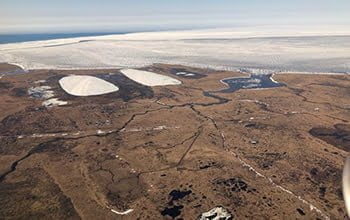
[ad_1]
Research News
Arctic coastal watersheds are some of the most threatened regions on Earth
June 2, 2020
Arctic coastal watersheds are some of the most threatened regions on Earth, having undergone substantial climatic, physical and biological changes with the warming of the Earth, scientists have found.
Now, researchers at the National Science Foundation Beaufort Lagoon Ecosystems Long-Term Ecological Research site have discovered that small coastal waterbodies in the Arctic, especially ponds, are releasing carbon to the atmosphere due to increasing water temperatures and microbial activity.
The results were published in the journal Global Biogeochemical Cycles.
Previously calculated carbon budgets for the Arctic region often didn’t include measurements from small waterbodies and therefore underestimated the amount of carbon entering the atmosphere.
The team measured partial pressure of carbon dioxide (pCO2) in 20 tundra ponds, 6 thermokarst ponds, 6 rivers (freshwater and brackish), and 6 lakes near Utqiaġvik, Alaska, over four years in late summer.
The scientists were able to estimate that CO2 concentrations in tundra ponds have nearly doubled over the past 40 years.
The researchers found that air and water temperatures were the main drivers of daily variation in pCO2. For example, peak pCO2 levels aligned with dates in both 2017 and 2018 when air temperature exceeded 11.1 degrees C (51.9 degrees F).
The warmer temperatures appear to stimulate microbial mineralization of carbon, meaning that smaller bodies of water heat up faster and become substantial sources of atmospheric CO2. In contrast, nearshore coastal waters and larger freshwater lakes absorb atmospheric CO2.
With the continued warming of the Earth, Arctic aquatic carbon budgets will continue to shift. Beaufort Lagoon Ecosystems LTER scientists have shown that relatively small but abundant aquatic ecosystems in the region can have a significant influence on the overall carbon budget by releasing more CO2 into the atmosphere, an influence that will likely increase as permafrost melting allows greater subsurface water flow.
“This new knowledge from long-term measurements aids our understanding of how coastal lakes, ponds, and rivers contribute to the atmospheric carbon balance under varying environmental conditions,” says Roberto Delgado, a program director in NSF’s Office of Polar Programs.
—
NSF Public Affairs,
researchnews@nsf.gov
[ad_2]
Source link
China PR







